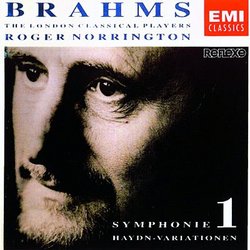| All Artists: Brahms, Norrington, Lcp Title: Symphony 1 / Haydn Variations Members Wishing: 0 Total Copies: 0 Label: EMI Classics Release Date: 10/11/1991 Genre: Classical Style: Symphonies Number of Discs: 1 SwapaCD Credits: 1 UPC: 077775428629 |
Search - Brahms, Norrington, Lcp :: Symphony 1 / Haydn Variations
 | Brahms, Norrington, Lcp Symphony 1 / Haydn Variations Genre: Classical
|
Larger Image |
CD Details |
CD ReviewsSupremely Underrated When Released, Rescued by Subsequent Hi Scott D. Harris | Chattanooga, TN | 07/05/2007 (5 out of 5 stars) "When these performances were first released, critical opinion was sharply critical - phrasing was wrong, gut strings were wrong, not how Brahms should sound, etc. Now, almost 15 years after Syms. 1 & 2 in this cycle and about 10 after the disc here, things have changed, at least in my view. I ordered this disc from an internet retailer in Japan, where all three discs in this cycle were available in 24-bit remastered releases by EMI_Toshiba. Needless to say, the sound is probably better than the original releases - as I listen, the strings are smooth, the accoustic is realistic and appropriately reverberant, and the brass and woodwinds sound well-balanced.
Recently, Sir Roger Norrington has begun to release Romantic-era recordings with his new orchestra in Stuttgart. In many of these performances, in which the orchestra uses modern instruments and strings, he has outlawed (for lack of a better term) the use of string vibrato by the orchestra about 97% of the time, claiming that the "continuous vibrato" used by the modern orchestra is something Brahms, Wagner, and their Romantic-era contemporaries would never have heard of, nor countenanced. In doing so, he has really taken the playing to an extreme, in my opinion. Orchestras in Brahms' day did use far less vibrato, but they still used it and it wasn't unheard of. That's why these London Classical Players recordings of the Brahms symphonies are the right balance. Norrington managed to strike the middle ground - we get period-based gut strings (which were still used regularly when Brahms wrote all his symphonies), period brass (smaller bore), period woodwind, but still judicious use of common string techniques like vibrato and portamento (though far from constant). Tempi are uniformly faster than was common in the 1990's and prior, though not as much today, thanks to the influence of recordings like these and those of Charles Mackerras. On top of all this, the performances themselves are really good. I particularly liked Symphonies 1, 2, and 4 - the faster tempi suit 1 and 2 really well. The melodies and main themes of these works just swing right along, nothing drags, though Norrington does slow down slightly where the music calls for it. Ditto for Symphony 4. I have listened to many performances of Brahms - these are some of my favorites. " |

 Track Listings (14) - Disc #1
Track Listings (14) - Disc #1